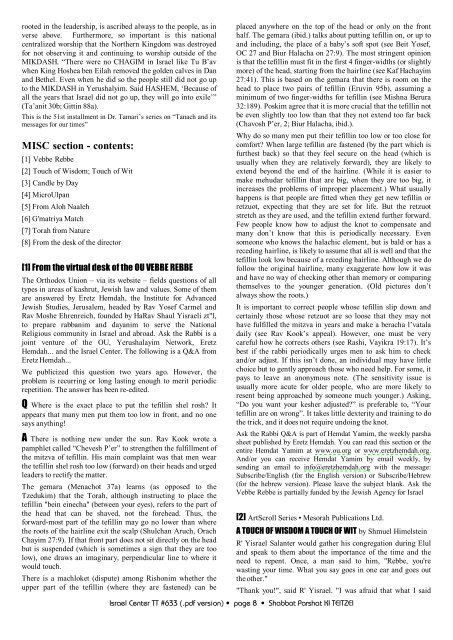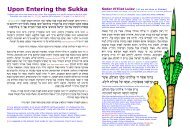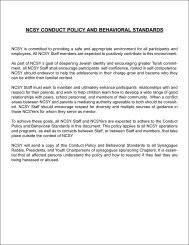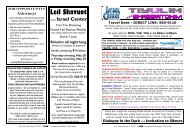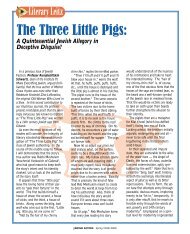You also want an ePaper? Increase the reach of your titles
YUMPU automatically turns print PDFs into web optimized ePapers that Google loves.
ooted in the leadership, is ascribed always to the people, as in<br />
verse above. Furthermore, so important is this national<br />
centralized worship that the Northern Kingdom was destroyed<br />
for not observing it and continuing to worship outside of the<br />
MIKDASH. “There were no CHAGIM in Israel like Tu B’av<br />
when King Hoshea ben Eilah removed the golden calves in Dan<br />
and Bethel. Even when he did so the people still did not go up<br />
to the MIKDASH in Yerushalyim. Said HASHEM, ‘Because of<br />
all the years that Israel did not go up, they will go into exile’”<br />
(Ta’anit 30b; Gittin 88a).<br />
This is the 51st installment in Dr. Tamari’s series on “Tanach and its<br />
messages for our times”<br />
MISC section contents:<br />
[1] Vebbe Rebbe<br />
[2] Touch of Wisdom; Touch of Wit<br />
[3] Candle by Day<br />
[4] MicroUlpan<br />
[5] From Aloh Naaleh<br />
[6] G'matriya Match<br />
[7] Torah from Nature<br />
[8] From the desk of the director<br />
[1] From the virtual desk of the OU VEBBE REBBE<br />
The <strong>Orthodox</strong> <strong>Union</strong> –via its website –fields questions of all<br />
types in areas of kashrut, Jewish law and values. Some of them<br />
are answered by Eretz Hemdah, the Institute for Advanced<br />
Jewish Studies, Jerusalem, headed by Rav Yosef Carmel and<br />
Rav Moshe Ehrenreich, founded by HaRav Shaul Yisraeli zt"l,<br />
to prepare rabbanim and dayanim to serve the National<br />
Religious community in Israel and abroad. Ask the Rabbi is a<br />
joint venture of the OU, Yerushalayim Network, Eretz<br />
Hemdah... and the Israel Center. The following is a Q&A from<br />
Eretz Hemdah...<br />
We publicized this question two years ago. However, the<br />
problem is recurring or long lasting enough to merit periodic<br />
repetition. The answer has been reedited.<br />
Q Where is the exact place to put the tefillin shel rosh? It<br />
appears that many men put them too low in front, and no one<br />
says anything!<br />
A There is nothing new under the sun. Rav Kook wrote a<br />
pamphlet called “Chevesh P’er”to strengthen the fulfillment of<br />
the mitzva of tefillin. His main complaint was that men wear<br />
the tefillin shel rosh too low (forward) on their heads and urged<br />
leaders to rectify the matter.<br />
The gemara (Menachot 37a) learns (as opposed to the<br />
Tzedukim) that the Torah, although instructing to place the<br />
tefillin "bein einecha" (between your eyes), refers to the part of<br />
the head that can be shaved, not the forehead. Thus, the<br />
forwardmost part of the tefillin may go no lower than where<br />
the roots of the hairline exit the scalp (Shulchan Aruch, Orach<br />
Chayim 27:9). If that front part does not sit directly on the head<br />
but is suspended (which is sometimes a sign that they are too<br />
low), one draws an imaginary, perpendicular line to where it<br />
would touch.<br />
There is a machloket (dispute) among Rishonim whether the<br />
upper part of the tefillin (where they are fastened) can be<br />
placed anywhere on the top of the head or only on the front<br />
half. The gemara (ibid.) talks about putting tefillin on, or up to<br />
and including, the place of a baby’s soft spot (see Beit Yosef,<br />
OC 27 and Biur Halacha on 27:9). The most stringent opinion<br />
is that the tefillin must fit in the first 4 fingerwidths (or slightly<br />
more) of the head, starting from the hairline (see Kaf Hachayim<br />
27:41). This is based on the gemara that there is room on the<br />
head to place two pairs of tefillin (Eruvin 95b), assuming a<br />
minimum of two fingerwidths for tefillin (see Mishna Berura<br />
32:189). Poskim agree that it is more crucial that the tefillin not<br />
be even slightly too low than that they not extend too far back<br />
(Chavosh P’er, 2; Biur Halacha, ibid.).<br />
Why do so many men put their tefillin too low or too close for<br />
comfort? When large tefillin are fastened (by the part which is<br />
furthest back) so that they feel secure on the head (which is<br />
usually when they are relatively forward), they are likely to<br />
extend beyond the end of the hairline. (While it is easier to<br />
make mehudar tefillin that are big, when they are too big, it<br />
increases the problems of improper placement.) What usually<br />
happens is that people are fitted when they get new tefillin or<br />
retzuot, expecting that they are set for life. But the retzuot<br />
stretch as they are used, and the tefillin extend further forward.<br />
Few people know how to adjust the knot to compensate and<br />
many don’t know that this is periodically necessary. Even<br />
someone who knows the halachic element, but is bald or has a<br />
receding hairline, is likely to assume that all is well and that the<br />
tefillin look low because of a receding hairline. Although we do<br />
follow the original hairline, many exaggerate how low it was<br />
and have no way of checking other than memory or comparing<br />
themselves to the younger generation. (Old pictures don’t<br />
always show the roots.)<br />
It is important to correct people whose tefillin slip down and<br />
certainly those whose retzuot are so loose that they may not<br />
have fulfilled the mitzva in years and make a beracha l’vatala<br />
daily (see Rav Kook’s appeal). However, one must be very<br />
careful how he corrects others (see Rashi, Vayikra 19:17). It’s<br />
best if the rabbi periodically urges men to ask him to check<br />
and/or adjust. If this isn’t done, an individual may have little<br />
choice but to gently approach those who need help. For some, it<br />
pays to leave an anonymous note. (The sensitivity issue is<br />
usually more acute for older people, who are more likely to<br />
resent being approached by someone much younger.) Asking,<br />
“Do you want your kesher adjusted?”is preferable to, “Your<br />
tefillin are on wrong”. It takes little dexterity and training to do<br />
the trick, and it does not require undoing the knot.<br />
Ask the Rabbi Q&A is part of Hemdat Yamim, the weekly parsha<br />
sheet published by Eretz Hemdah. You can read this section or the<br />
entire Hemdat Yamim at www.ou.org or www.eretzhemdah.org.<br />
And/or you can receive Hemdat Yamim by email weekly, by<br />
sending an email to info@eretzhemdah.org with the message:<br />
Subscribe/English (for the English version) or Subscribe/Hebrew<br />
(for the hebrew version). Please leave the subject blank. Ask the<br />
Vebbe Rebbe is partially funded by the Jewish Agency for Israel<br />
[2] ArtScroll Series •Mesorah Publications Ltd.<br />
A TOUCH OF WISDOM A TOUCH OF WIT by Shmuel Himelstein<br />
R' Yisrael Salanter would gather his congregation during Elul<br />
and speak to them about the importance of the time and the<br />
need to repent. Once, a man said to him, "Rebbe, you're<br />
wasting your time. What you say goes in one ear and goes out<br />
the other.''<br />
"Thank you!", said R' Yisrael. "I was afraid that what I said<br />
Israel Center TT #633 (.pdf version) · page 8 · Shabbat Parshat KI TEITZEI


